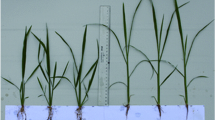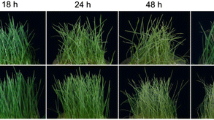Abstract
Rice is the major staple food for one-third of the world’s population. Rice requires high amount of water as compared to other cereal crops. In this context, we screened traditional rice genotypes collected from RARS, Pattambi and Ambalavayal for drought tolerance. Based on the morpho-physiological characters, the plants which showed wilting symptoms were screened according to international standard i.e., IRRI leaf score 7.0. The genotype which showed no wilting symptom even after 90% of the plants were showing wilting was identified as tolerant and the plant which showed early wilting symptom was identified as susceptible genotype. The genotype Chuvanna Modan has taken 25 days and the genotype Parambuvattan has taken only 10 days for wilting. After 90% of plants reached IRRI score 7.0 phenotypic observations i.e., electrical conductivity, measurement of stomatal conductance and transpiration rate using Infra red gas analyser were recorded. Root traits were also measured. The identified tolerant and susceptible genotypes were further subjected to 2D gel electrophoresis to identify and characterize the differentially expressed proteins for drought tolerance. Totally four differentially expressed protein spots were identified in Chuvanna Modan. The differential protein spots were sequenced by Matrix Assisted Laser Desorption/Ionization–Time of Flight Mass Spectrometry (MALDI–TOF/MS). Spot 1 and 2 were identified as ribulose bisphosphate carboxylase small subunit, spot 3 was identified as Protein tyrosine phosphatases and spot 4 was identified as Photosystem II stability/assembly factor HCF136.




Similar content being viewed by others
References
Ali, M. L., Pathan, M. S., Zhang, J., Bai, G., Sarkarung, S., & Nguyen, H. T. (2000). Mapping QTLs for root traits in recombinant inbred population from two indica ecotypes in rice. Theoretical and Applied Genetics, 101, 756–766.
Armento-Soto, J., Chang, T. T., Loresto, G. C., & O’toole, J. C. (1983). Genetic analysis of root characters in rice (Oryza sativa L.) SABRAO association and path coefficient analysis in Indica X japonica doubled haploid population of rice. Oryza, 36, 10–12.
Boonjung, H., & Fukai, S. (1996). Effects of soil water deficit at different growth stages on rice growth and yield under upland conditions. Field Crops Research, 48, 47–55.
Cabuslay, G. S., Ito, O., & Alejar, A. (1999). Genotypic differences in physiological responses to water deficit in rice. Genetic improvement of rice for water-limited environments (pp. 99–116). Philippines: International Rice Research Institute.
Chandrababu, R., Shashidhar, H. E., Lilley, J. M., Thanh, N. D., Ray, J. D., Sadasivam, S., et al. (2001). Variation in root penetration ability, osmotic adjustment and dehydration tolerance among accessions of rice adapted to rainfed lowland and upland ecosystems. Plant Breeding, 120(3), 233–238.
Clark, L. J., Price, A. H., Steele, K. A., & Whalley, W. R. (2008). Evidence from near-isogenic lines that root penetration increases with root diameter and bending stiffness in rice. Functional Plant Biology, 35(11), 1163–1171.
Damerval, C., de Vienne, D., Zivy, M., & Thiellement, H. (1986). Technical improvements in two-dimensional electrophoresis increase the level of genetic variation detected in wheat-seedling proteins. Electrophoresis, 7, 52–54.
Das, A., Eldakak, M., Paudel, B., Kim, D. W., Hemmati, H., Basu, C., et al. (2016). Leaf proteome analysis reveals prospective drought and heat stress response mechanisms in soybean. BioMed Research International, 2016, 23p.
Dixon, J. E., & Denu, J. M. (1998). Protein tyrosine phosphatases: Mechanisms of catalysis and regulation. Current Opinion in Chemical Biology, 2(5), 125–135.
Ekanayake, I. J., Garrity, D. P., Masajo, T. M., & O’toole, J. C. (1985). Root pulling resistance in rice: Inheritance and association with drought tolerance. Euphytica, 34, 905–913.
Fayez, K. A. (2000). Action of photosynthetic diuron herbicide on cell organelles and biochemical constituents of the leaves of two soybean cultivars. Pesticide Biochemistry and Physiology, 66, 105–115.
Gana, A. S. (2011). Screening and resistance of traditional and improved cultivars of rice to drought stress at Badeggi, Niger State, Nigeria. Agriculture and Biology Journal of North America, 2(6), 1027–1031.
Gomez, K. A., & Gomez, A. A. (1976). Statistical Procedures in Agricultural Research. Los Banos, Philippiness: Internatioanl Rice Research Institute.
Hirasawa, T., Ito, O., & Hardy, B. (1999). Physiological characterization of the rice plant for tolerance of water deficit. Genetic Improvement Rice for Water-Limited Environment (pp. 89–98). Philippines: IRRI.
Hsiao, T. C. (1973). Plant responses to water stress. Annual Review of Plant Physiology, 24, 519–570.
Ingram, K. T., Bueno, F. O., Namuco, O. S., Yambao, E. B., & Beyrouty, C. A. (1994). Rice root traits for drought resistance and their genetic variation. In G. J. O. Kirk (Ed.), Rice Roots: Nutrient and Water use (pp. 67–77). Los Banos, Philippines: IRRI.
IRRI (International Rice Research Institute). (1996). Standard evaluation system for rice (p. 102). Los Banos: International Rice Research Institute.
Jagadish, S. V. K., Septiningsih, E. M., Kohli, A., Thomson, M. J., Ye, C., Redoña, E., et al. (2012). Genetic advances in adapting rice to a rapidly changing climate. Journal of Agronomy and Crop Science, 198, 360–373.
Jaleel, C. A., Manivannan, P., Sankar, B., Kishorekumar, A., Gopi, R., Somasundaram, R., et al. (2007). Pseudomonas fluorescens enhances biomass yield and ajmalicine production in Catharanthus roseus under water deficit stress. Colloids and Surfaces B: Biointerfaces, 60, 7–11.
Kamo, M., Kawakami, T., Miyatake, N., & Tsugita, A. (1995). Separation and characterization of Arabidopsis thaliana proteins by two dimensional gel electrophoresis. Electrophoresis, 16, 423–430.
Kato, Y., Kamoshita, A., & Yamagishi, J. (2007). Evaluating the resistance of six rice cultivars to drought: Root restriction and the use of raised beds. Plant and Soil, 300, 149–161.
Kramer, P. J. (1937). The relation between rate of transpiration and rate of absorption of water in plants. American Journal of Botany, 24, 10–15.
Lilley, J. M., & Fukai, S. (1994). Effect of timing and severity of water deficit on four diverse rice cultivars: Rooting pattern and soil water extraction. Field Crops Research, 37, 205–213.
Liu, B., Fan, J., Zhang, Y., Mu, P., Wang, P., Su, J., et al. (2012). OsPFA-DSP1, a rice protein tyrosine phosphatase, negatively regulates drought stress responses in transgenic tobacco and rice plants. Plant Cell Reports, 31(6), 1021–1032.
O’Toole, J. C. (1982). Adaptation of rice to drought –prone environment: Drought resistance in crops with emphasis on rice. Journal of Science and Biotechnology, 12, 195–213.
O’Toole, J. C. (2004). Rice and water: The final frontier. In Paper presented at the First International Conference on Rice for the Future. 31 August–2 September. Bangkok, Thailand (pp. 1–24).
O’toole, J. C., & Cruz, R. T. (1980). Response of leaf water potential, stomatal resistance and leaf rolling to water stress. Plant Physiology, 65, 428–432.
O’Toole, J. C., & De Datta, S. K. (1986). Drought resistance in rainfed lowland rice. Progress in Rainfed Lowland Rice (pp. 145–158). Philippines: International Rice Research Institute.
Pandey, S., Bhandari, H. & Hardy, B. (2007). Economic costs of drought and rice farmers’ coping mechanisms: A cross-country comparative analysis. International Rice Research Institute. Los Baños (Philippines), 203 p.
Parker, R., Timothy, J. F., Moore, A. L., & Harpham, N. V. J. (2006). An accurate and reproducible method for proteome profiling of the effects of salt stress in the rice leaf lamina. Journal of Experimental Botany, 57(5), 1109–1118.
Plucken, H., Muller, B., Grohmann, O., Westhoff, P., & Eichacker, L. A. (2002). A nuclear–encoded protein of prokaryotic origin is essential for the stability of PS II in Arabidopsis Thaliana. EMBO Journal, 15, 88–93.
Price, A. H., Cairns, J. E., Horton, P., Jones, H. G., & Griffiths, H. (2002). Linking drought resistance mechanisms to drought avoidance in upland rice using a QTL approach: Progress and new opportunities to integrate stomatal and mesophyll responses. Journal of Experimental Botany, 53, 989–1004.
Price, A. H., Young, E. M., & Tomos, A. D. (1997). Quantitative trait loci associated with stomatal conductance, leaf rolling and heading date mapped in upland rice (Oryza sativa L.). New Phytology, 137, 83–91.
Sorte, N. V., Deotale, R. D., Patankar, M. N., Narkhede, A. H., Golliwar, V. J., & Katole, B. D. (1992). Root and shoot physiology as influenced by short term water stress in upland paddy. Journal of Soils and Crops, 2(1), 86–91.
Spreitzer, R. J. (2003). Role of the small subunit in ribulose-1,5-bisphosphate carboxylase/oxygenase. Archives of Biochemistry and Biophysics, 414, 141–149.
Taiz, L., & Zeiger, E. (2006). Plant Physiology (4th ed.). Sunderland, MA: Sinauer Associates Inc. Publishers.
Toorchi, M., Shashidhar, H. E., & Sridhara, H. (2006). Influence of the root system on grain yield and related characters in rainfed lowland rice (Oryza sativa L.). Pakistan Journal of Biological Sciences, 9(12), 2267–2272.
Vu, J. C. V., Gesch, R. W., Allen, L. H., Jr., Boote, K. J., & Bowes, G. (1999). CO2 enrichment delays a rapid, drought-induced decrease in rubisco small subunit transcript abundance. Journal of Plant Physiology, 155(1), 139–142.
Wassmann, R., Jagadish, S. V. K., Sumfleth, K., Pathak, H., Howell, G., Ismail, A., et al. (2009). Regional vulnerability of climate change imapcts on Asian rice production and scope for adaptation. Advances in Agronomy, 102, 91–133.
Wu, Y., & Cosgrove, D. J. (2000). Adaptation of roots to lower water potentials by changes in cell wall extensibility and cell wall proteins. Journal of Experimental Botany, 51(350), 1543–1553.
Yoshida, S., & Hasegawa, S. (1982). The rice root system: Its development and function. In: Drought resistance in cereals crops with emphasis on rice. Proceedings of an International work shop. Los Banos: International Rice Research Institute (pp. 53–58).
Acknowledgements
We thankful to the Centre for Plant Biotechnology and Molecular Biology, College of Horticulture, Kerala Agricultural University, Thrissur for providing facilities for the work. We also thankful to the Department of Biotechnology (DBT), Govt. of India for providing fellowship and funding for the research.
Author information
Authors and Affiliations
Corresponding author
Rights and permissions
About this article
Cite this article
Prathi, N.B., Salim, A.P., Beena, R. et al. Morpho-physiological and proteomic analysis to identify and characterise the traditional rice genotypes for drought tolerance. Ind J Plant Physiol. 23, 785–795 (2018). https://doi.org/10.1007/s40502-018-0405-5
Received:
Accepted:
Published:
Issue Date:
DOI: https://doi.org/10.1007/s40502-018-0405-5




